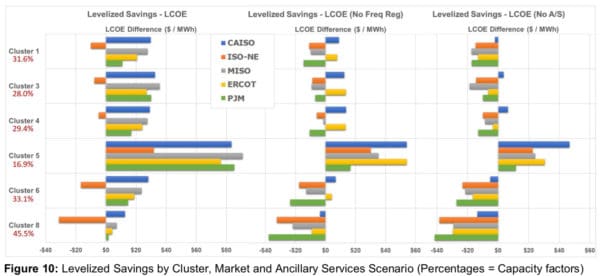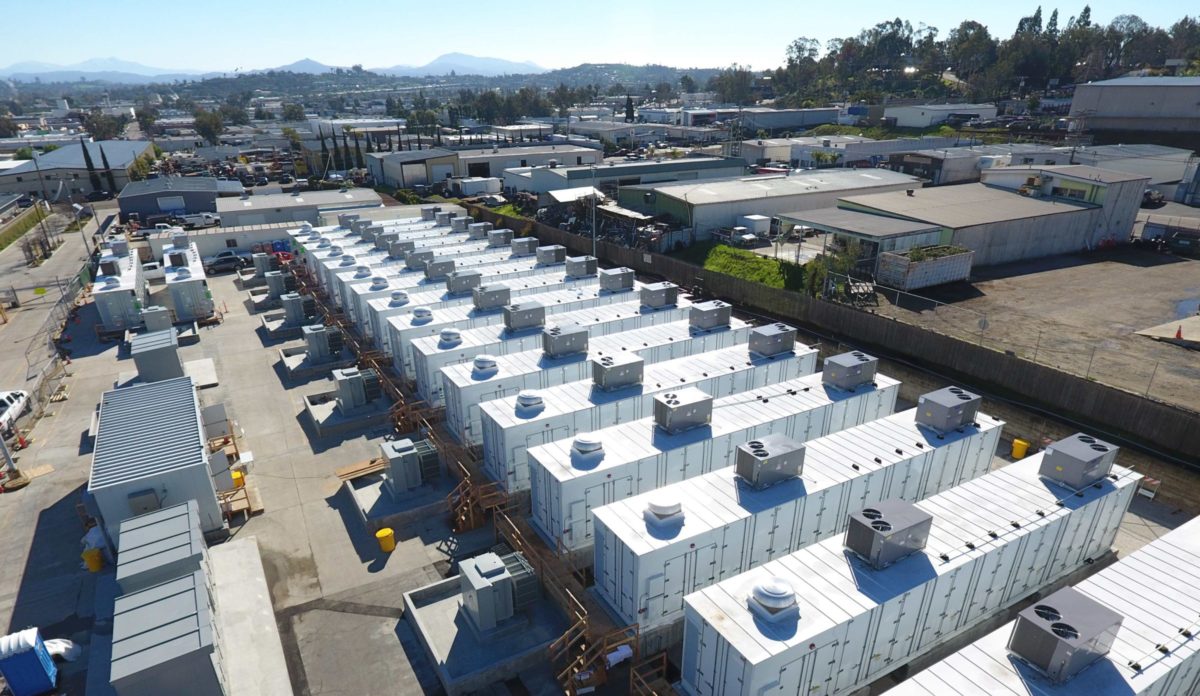Solar plus storage has begun displacing new natural gas peaking units in Arizona, and 8minuteenergy Renewables CEO Tom Buttgenbach has said his firm can build solar plus storage at a lower price than gas peakers “anywhere in the country today.”
A new study shows that solar plus storage (S+S) also outcompetes new “mid-merit” gas units in four of five grid service areas across the nation in a scenario where current rates of compensation for grid services hold steady over 30 years. S+S also costs less than these gas units in a number of other cases studied. The study was published by battery maker Fluence, a joint venture of Siemens and AES.
Mid-merit or “load-following” units operate at an average capacity factor of about 15% to 45%, mid-way between peaker and “baseload” fossil-fired or nuclear units.
The analysis used generation data from 435 U.S. natural gas combined cycle (NGCC) units to develop six “clusters” of NGCCs grouped partly by their capacity factor (i.e., percent utilization).
The levelized savings from choosing an S+S unit over a new NGCC unit for each cluster, across five different grid regions and three scenarios, are shown here:

(Clusters 2 and 7 are not shown as they represent gas peakers.)
The drivers for cost savings from choosing S+S include:
- Substituting for a low-utilization NGCC, as in Cluster 5
- Compensation for ancillary grid services at current prices over the next 30 years, as in the first scenario at left
- High insolation, as in California’s CAISO grid region, shown in blue.
While the first scenario at left assumes that revenues for grid services will remain at current levels over a unit’s 30-year lifetime, the second scenario assumes no revenues for the grid service of frequency regulation, while the third scenario assumes no grid service revenues at all—and in that scenario, “savings” are generally negative versus mid-tier NGCC.
S+S units required six hours of battery storage for five of the clusters, but required only four hours of battery storage for Cluster 5. (For more detail on the analysis, see the technical notes below.)
“A key aspect of the analysis is novel,” said Carnegie Mellon University (CMU) finance professor Chris Telmer, who together with CMU professor Jay Apt supervised the seven Carnegie Mellon MBA students who conducted the analysis. “The students got data on what hundreds of mid-merit NGCC plants are doing and then specified solar+storage assets in order to replicate the NGCC ‘jobs being done.’”
“To the best of our knowledge,” Dr. Telmer added, “nobody has asked this question before. It is a very different question from ‘what is the LCOE of a new build solar+storage facility in location X.’ While the answer is certainly not the last word on the economic comparison between gas and S+S, the question is one that is of obvious interest to both developers and utilities.”
The research project represents “case-based education at its best: substantial, unstructured, and about as real-world as it gets,” said Dr. Telmer. For such projects, he said that a firm such as Fluence “poses a problem that they are currently struggling with,” and as part of a semester-long MBA capstone course, “the students are let loose on it, supervised by university faculty and representatives of the sponsoring firm,” with the firm providing financial support to Carnegie Mellon’s Tepper School of Business. “The model is that the firm gets good value for its money in that the result of the project yields new business insights,” he said.
The industry representative was Dr. Colleen Lueken, Lead Data Scientist with Fluence, who holds a Ph.D. in engineering and public policy from Carnegie Mellon. Her thesis adviser was Dr. Jay Apt, who co-supervised the seven student authors; Dr. Apt is a business/engineering professor with extensive research and consulting experience related to the electric power industry. Dr. Lueken has published a post on the study and her role.
The seven student authors, in reverse alphabetical order (there was no senior author) are Tom Reeves, Zack Lippert, Brian Freeman, Dave Deckelman, Ben Cerroni, Panagiotis Bourtsalas, and Matt Beers.
Asked if anyone should be “amazed” by the quality of the student work, Dr. Telmer replied:
“No, you should not be amazed. This sort of analysis requires (i) some basic technical understanding of how the electrical power system works and how storage works, (ii) some basic financial analysis and cash flow modeling skills, and (iii) supervision from academic and industry people who have relevant experience. An MBA student with an engineering background who worked hard in their finance classes and who then joined an appropriately-supervised team of peers should be able to perform the analysis contained in the Tepper/CMU white paper.”
Dr. Telmer added, “Tepper is committed to educating the future leaders of the clean energy industry. This isn’t cheap and it isn’t easy, but the Tepper study shows that it is being done.”
Technical notes
The analysis assumes a cost of $1,100 per kilowatt for four-hour storage, and $1,500 per kilowatt for six-hour storage. The modeled power plants all have 100 MW of AC output. The project lifetime is assumed to be 30 years, with the first year of operation beginning in 2020. The cost of equity is 10%, and no debt financing is used. The original battery storage capacity is maintained in the model by augmenting with modest additional capacity, occasionally over the 30-year lifetime, according to Dr. Lueken.
The report notes that the net savings analysis for solar plus storage “can be modified to include additional benefits that are not considered here, such as a carbon price or ramping service.”
The authors add that the research methods could also be used “to compare a fleet of wind, solar, batteries and aggregated demand response to a baseload thermal resource,” as the research methods are “flexible and extensible.”
The authors expect that “Even as the ITC phases out through 2023, reductions in S+S costs will improve the combined technologies’ economics over NGCC plants.” They cite a Wood Mackenzie Power and Renewables forecast of “6% and 8% annual reductions in all-in cost for front-of-the-meter solar PV and energy storage, respectively, between 2018 and 2022.”
The research team used a “k-means cluster analysis” algorithm to group the NGCCs into clusters, yet the team’s further analysis did not identify systematic characteristics with each cluster. “Therefore,” the authors write, “the reader should simply interpret our cluster analysis as having identified reliable, reduced-form patterns in the generation profiles—the “jobs”—that constitute our dataset.”
The authors caution that “it is critical to accurately describe the production profile, or ‘job,’ that a new mid-merit generation asset is needed to provide. Careful and detailed description is necessary to size and configure an S+S asset that can be accurately compared with an NGCC plant on a net LCOE basis. Capacity factor alone is insufficient for modeling what a mid-merit resource will do, as highlighted by the clustering analysis of the operating profiles of 435 NGCC plants.”
This content is protected by copyright and may not be reused. If you want to cooperate with us and would like to reuse some of our content, please contact: editors@pv-magazine.com.








By submitting this form you agree to pv magazine using your data for the purposes of publishing your comment.
Your personal data will only be disclosed or otherwise transmitted to third parties for the purposes of spam filtering or if this is necessary for technical maintenance of the website. Any other transfer to third parties will not take place unless this is justified on the basis of applicable data protection regulations or if pv magazine is legally obliged to do so.
You may revoke this consent at any time with effect for the future, in which case your personal data will be deleted immediately. Otherwise, your data will be deleted if pv magazine has processed your request or the purpose of data storage is fulfilled.
Further information on data privacy can be found in our Data Protection Policy.